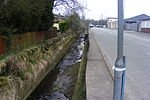Newby Mill, Shaw
1890 establishments in EnglandBuildings and structures completed in 1890Buildings and structures demolished in 2022Demolished buildings and structures in EnglandFormer textile mills in the United Kingdom ... and 3 more
Shaw and CromptonTextile mills in the Metropolitan Borough of OldhamTextile mills owned by the Lancashire Cotton Corporation

Elm Mill, was a four-storey cotton spinning mill in Shaw and Crompton, Greater Manchester, England. It was built in 1890 for the Elm Spinning Company Ltd., and was called Elm Mill until it closed in 1928. It was revived by the Lancashire Cotton Corporation in 1929 and called Newby Mill. LCC and all their assets passed to Courtaulds in 1964. Production at Newby finished in 1970, and it was used for warehousing. Subsequently, named Shaw No 3 Mill, it became part of Littlewood's Shaw National Distribution Centre. It was demolished to make way for housing in 2022.
Excerpt from the Wikipedia article Newby Mill, Shaw (License: CC BY-SA 3.0, Authors, Images).Newby Mill, Shaw
Hillside Avenue,
Geographical coordinates (GPS) Address Phone number Nearby Places Show on map
Geographical coordinates (GPS)
| Latitude | Longitude |
|---|---|
| N 53.5809 ° | E -2.0857 ° |
Address
East Crompton St George's CofE School
Hillside Avenue
OL2 8AX , Clough
England, United Kingdom
Open on Google Maps







